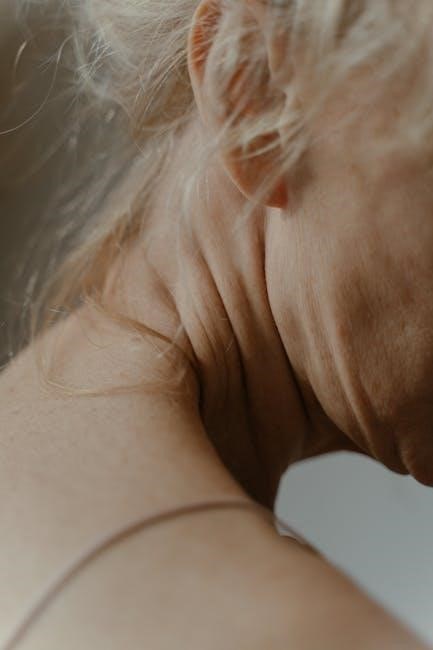A structured rehabilitation approach is crucial for recovery after shoulder dislocation, focusing on individualized programs, three-phase progression, and initial immobilization to restore strength and stability effectively.
1.1 Overview of Shoulder Dislocation
A shoulder dislocation occurs when the humerus detaches from the glenoid cavity, often due to trauma, falls, or sports injuries. It is classified as anterior or posterior, with anterior being the most common. Immediate symptoms include pain, limited mobility, and a visible deformity. Early rehabilitation is essential to restore joint stability and prevent recurrent dislocations. The injury requires a structured approach to ensure proper healing and functional recovery, addressing both the physical and mechanical aspects of the shoulder joint.
1.2 Importance of Rehabilitation
Rehabilitation is vital for restoring shoulder function, strength, and stability after a dislocation. It reduces the risk of recurrence, enhances joint mobility, and addresses muscle imbalances. A well-structured program minimizes pain, prevents chronic instability, and promotes a return to daily activities or sports. Early intervention also reduces fear of movement and psychological barriers to recovery. Tailored rehab protocols ensure individualized care, addressing specific needs and goals, particularly for athletes or those with recurrent dislocations. Proper rehabilitation is essential for achieving long-term shoulder health and preventing future complications.

1.3 Goals of the Rehab Protocol
The primary goals of a shoulder dislocation rehab protocol are to restore joint stability, improve range of motion, and strengthen surrounding muscles. The program aims to eliminate pain, prevent recurrent dislocations, and enhance functional mobility. It also focuses on addressing muscle imbalances and improving proprioception. Additionally, the protocol ensures a gradual return to daily activities or sports, minimizing the risk of re-injury. Achieving these objectives helps patients regain confidence and independence in using their shoulder, ensuring optimal long-term recovery and reducing the likelihood of future complications.

Understanding the Injury
Shoulder dislocation occurs when the humerus detaches from the glenoid, causing pain and instability. It often results from trauma, falls, or sports injuries, requiring immediate care.
2.1 Types of Shoulder Dislocations
Shoulder dislocations are classified based on the direction of the humerus displacement. Anterior dislocations occur when the humerus moves forward, posterior when it moves backward, and inferior when it shifts downward. Recurrent dislocations involve repeated episodes. Each type requires tailored rehabilitation approaches to address specific instability patterns and restore joint function. Accurate diagnosis is essential for developing effective treatment plans.
2.2 Common Causes and Risk Factors
Shoulder dislocations often result from falls, sports injuries, or direct trauma. Recurrent dislocations are a significant risk factor, especially in young males and athletes. Previous dislocations increase the likelihood of recurrence. Activities involving overhead movements or contact sports also elevate risk. Understanding these causes and risk factors is crucial for developing targeted prevention strategies and rehabilitation plans to minimize future episodes and restore shoulder stability.
2.3 Immediate Post-Injury Care
Immediate care for shoulder dislocation involves immobilizing the joint to reduce pain and prevent further damage. Applying ice helps minimize swelling. Pain management may include over-the-counter medications. It’s crucial to avoid movement until professional evaluation. A healthcare provider will typically reduce the dislocation and recommend immobilization for 4-6 weeks. Proper initial care sets the foundation for effective rehabilitation, ensuring the shoulder heals correctly and reducing the risk of recurrent dislocations.
Phases of Shoulder Dislocation Rehabilitation
Shoulder dislocation rehabilitation progresses through three phases: Early Rehab (Weeks 2-4), Strengthening (Weeks 5-8), and Advanced Strengthening with return to activity (Weeks 9-12), ensuring gradual recovery and restored function.
3.1 Phase 1: Early Rehab (Weeks 2-4)
Phase 1 focuses on pain management, immobilization, and gentle mobilization to restore basic shoulder movement. Patients often use slings for support during this period. Pendulum exercises and isometric strengthening are introduced to maintain muscle activity without stressing the joint. Passive range-of-motion exercises are performed to prevent stiffness. The goal is to minimize pain and inflammation while preparing the shoulder for more active rehabilitation in subsequent phases. This phase is critical for laying the foundation for successful recovery and preventing further injury.
3.2 Phase 2: Strengthening (Weeks 5-8)
Phase 2 focuses on progressive strengthening to enhance shoulder stability and muscle endurance. Isometric exercises, such as shoulder blade squeezes and arm-to-the-wall pushes, are introduced to build strength without joint movement. Dynamic exercises, like resistance band rows and lateral raises, are gradually incorporated to improve functional movement. Patients may also begin using light weights or resistance bands to target the rotator cuff and scapular muscles. The goal is to restore strength and prepare the shoulder for more advanced activities while minimizing the risk of re-injury.
3.3 Phase 3: Advanced Strengthening and Return to Activity (Weeks 9-12)
Phase 3 emphasizes advanced strengthening and functional activities to prepare for a full return to daily or athletic activities. Exercises progress to higher resistance, such as plyometric drills and dynamic stabilization exercises, to enhance power and endurance. Sports-specific movements are reintroduced, focusing on proper mechanics to reduce injury risk. The rotator cuff and scapular muscles are further strengthened to ensure joint stability. Patients gradually resume pre-injury activities, with progression tailored to individual goals and functional assessments, ensuring a safe and effective transition back to full activity levels.

Exercises for Each Phase
Exercises are tailored to each phase, progressing from basic mobility to advanced strengthening, ensuring a gradual and safe return to normal shoulder function and activity levels.
4.1 Phase 1 Exercises
Phase 1 focuses on pain management and basic mobility. Pendulum exercises, shoulder circles, and isometric strengthening are commonly used to restore gentle movement without stressing the joint. Patients perform these exercises 2-3 times daily, emphasizing controlled, slow movements to avoid further injury. The goal is to improve range of motion and reduce stiffness while protecting the shoulder during the initial healing process. These exercises are low-intensity and designed to lay the foundation for more advanced rehabilitation in later phases.
4.2 Phase 2 Exercises
Phase 2 introduces strengthening exercises to restore functional strength and improve joint stability. Isotonic exercises, such as shoulder rotations with resistance bands or light weights, are commonly used. Dynamic strengthening exercises, like arm raises and wall slides, are also incorporated to enhance muscle endurance. Patients typically perform these exercises 3-4 times weekly, gradually increasing resistance and repetitions. The focus is on rebuilding muscle strength while maintaining proper form to prevent re-injury. These exercises prepare the shoulder for more advanced movements in later phases.
4.3 Phase 3 Exercises
Phase 3 focuses on advanced strengthening and functional activities to prepare for a full return to activity. Dynamic strengthening exercises, such as plyometric drills and high-resistance band work, are introduced to enhance power and endurance. Sport-specific or job-specific movements are incorporated to mimic real-life demands. Patients also engage in proprioceptive exercises to improve joint awareness and stability. The intensity and complexity of exercises increase, with a focus on maintaining proper form and preventing recurrence. This phase typically lasts 4-6 weeks, with exercises performed 4-5 times weekly to ensure readiness for unrestricted activity.

Treatment Options
Treatment includes physical therapy, immobilization, and surgical intervention. Physical therapy focuses on strengthening and mobility, while immobilization stabilizes the shoulder post-injury. Surgery is considered for recurrent dislocations.
5.1 Physical Therapy
Physical therapy is a cornerstone of shoulder dislocation rehabilitation, focusing on restoring mobility, strength, and stability. It typically begins with gentle exercises like pendulum movements and progresses to isometric and dynamic strengthening. Therapy sessions, often 2-3 times weekly for 6-8 weeks, are tailored to individual needs and goals. The program aims to enhance joint function, reduce pain, and prevent future dislocations. Customized exercises address specific deficits, promoting a gradual return to normal activities and sports, thereby minimizing the need for surgical intervention.
5.2 Immobilization Techniques
Immobilization is often the first step in shoulder dislocation rehabilitation, typically lasting 4-6 weeks for first-time dislocators. Slings or braces are used to restrict shoulder movement, allowing the joint to heal and reducing the risk of recurrent dislocation. This period is critical for minimizing further injury and promoting initial recovery. The duration may vary based on the severity of the injury and patient compliance. Immobilization is followed by gradual mobilization and physical therapy to restore strength and mobility, ensuring a balanced approach to recovery.
5.3 Surgical Intervention
Surgical intervention is considered for recurrent dislocations or significant structural damage. Procedures like Bankart repair or Latarjet are common, aiming to stabilize the shoulder joint. Surgery is typically recommended when conservative treatments fail or when there are high-risk factors for further dislocation. The goal is to repair or reinforce damaged tissues, such as the labrum or ligaments, to restore joint stability. Recovery post-surgery involves a structured rehab program to regain strength and mobility, ensuring long-term stability and preventing future dislocations.

Rehabilitation Guidelines
Rehabilitation guidelines emphasize individualized programs, immobilization for 4-6 weeks, and progressive exercises to restore strength and stability, tailored to the patient’s condition and activity goals.

6.1 First-Time Dislocators
First-time shoulder dislocators typically require immobilization for 4-6 weeks to promote healing. Initial exercises focus on pendulum movements and isometric strengthening to maintain mobility without stress. Progression criteria include pain-free range of motion and adequate strength before advancing to dynamic exercises. Individualized programs are essential to address specific needs and activity goals, ensuring a safe transition to more intensive rehabilitation phases.
6.2 Recurrent Dislocators
Recurrent shoulder dislocations require a more aggressive rehabilitation approach due to increased instability and risk of further injury. Immobilization may still be recommended, but early mobilization and strengthening exercises are prioritized to enhance joint stability. Programs often include advanced isometric and dynamic exercises to address muscle imbalances. Surgical intervention is considered if conservative measures fail to prevent recurring dislocations. Progression criteria are stricter, focusing on achieving full strength and stability before returning to high-risk activities. Individualized plans are tailored to address the underlying causes of recurrence and prevent future episodes.
6.4 Progression Criteria
Progression through the rehabilitation phases is guided by specific criteria, including pain reduction, improved range of motion, and strength gains. Patients must demonstrate stable shoulder mechanics and functional ability before advancing. Time-based milestones are less emphasized compared to individual readiness. Clinicians assess whether the patient has achieved the goals of the current phase, such as full pain-free movement or adequate strength, before transitioning. These criteria ensure a safe and effective progression, minimizing the risk of re-injury and optimizing recovery outcomes for both first-time and recurrent dislocators.
Role of Physical Therapy
Physical therapy plays a vital role in guiding patients through personalized rehab programs, focusing on pain management, mobility restoration, and strength building to prevent recurrence and enhance function.
7.1 Evaluation and Assessment
Evaluation and assessment are critical in developing a tailored rehab program. Clinicians assess pain levels, range of motion, strength, and joint stability to create a personalized plan. This initial evaluation helps identify specific deficits and guides the progression through rehab phases, ensuring a safe and effective recovery. Regular reassessments monitor progress and adjust the program as needed, focusing on achieving functional goals and preventing future dislocations.
7.2 Customized Rehab Programs
Customized rehab programs are essential for effective recovery, addressing individual needs and goals. These programs are tailored based on the patient’s specific injury, activity level, and rehabilitation progress. Clinicians design exercises to target strength, flexibility, and stability, ensuring a gradual and safe return to normal activities. Personalized plans help optimize recovery outcomes, reduce recurrence risk, and align with the patient’s lifestyle and objectives, making each program unique and adaptable throughout the rehabilitation journey.
7.3 Frequency and Duration of Sessions
Physical therapy sessions for shoulder dislocation rehab typically occur 2-3 times per week, with programs lasting 6-8 weeks. The duration and frequency are tailored to the individual’s progress and goals. Early stages focus on pain management and basic mobility, while later sessions emphasize strength and functional activities. Consistency is key to ensure proper healing and prevent recurrence. Sessions are adjusted based on the patient’s response and specific needs, ensuring a balanced approach to recovery and return to activity.

Shoulder-Specific Exercises
Shoulder-specific exercises, such as pendulum swings, isometric strengthening, and dynamic movements, are tailored to enhance mobility, strength, and stability, aiding in a full recovery from dislocation.
8.1 Pendulum Exercises
Pendulum exercises are a foundational part of shoulder rehabilitation, involving gentle, controlled movements to improve mobility. Patients stand and lean forward, supporting themselves on a table. The unaffected arm assists in swinging the affected arm in small circles, gradually increasing the size as comfort allows. This exercise enhances joint mobility without stressing the injured tissues. Typically performed in the early stages of rehab, pendulum exercises are repeated for 3 sets of 5-10 repetitions, helping restore range of motion and reducing stiffness effectively.
8.2 Isometric Strengthening
Isometric strengthening is a key component of shoulder rehabilitation, focusing on muscle contractions without joint movement. Patients perform exercises like wall slides or holding their arm in specific positions to build strength. These exercises are typically introduced in the early stages to promote stability and prevent further injury. By engaging the shoulder muscles without putting stress on the joint, isometric exercises help restore strength and control, laying the foundation for more dynamic movements in later phases of recovery.
8.3 Dynamic Strengthening
Dynamic strengthening introduces controlled movements to improve shoulder mobility and power. Exercises like shoulder rotations, arm circles, and resistance band workouts are commonly used. These activities help restore functional strength and endurance, preparing the shoulder for daily activities and sports. Progression involves increasing resistance or range of motion, ensuring the shoulder stabilizes effectively during movement. This phase is crucial for rebuilding confidence and reducing the risk of recurrent dislocations, bridging the gap between basic stability and full functional recovery.
Return to Activity
Return to activity involves gradual resumption of normal activities or sports, guided by regained strength, stability, and full range of motion, ensuring safe and effective reintegration.
9.1 Criteria for Returning to Sports
Return to sports requires achieving full, pain-free range of motion, strength equal to the uninjured shoulder, and successful completion of functional and dynamic stability tests. Clinicians assess readiness based on individual progress, ensuring the shoulder demonstrates sufficient stability and resilience for athletic demands. A gradual reintroduction to sport-specific movements is essential to prevent recurrence and ensure safe participation. The criteria emphasize both physical readiness and confidence in the shoulder’s functionality, guided by personalized rehab programs and clinical evaluation.
9.2 Gradual Integration of Activities
Gradual integration of activities ensures a safe transition from rehab to normal functioning. Start with light, controlled movements, progressing to dynamic exercises that mimic daily or sport-specific tasks. Emphasize proper technique to avoid re-injury. Monitor tolerance and gradually increase intensity, ensuring the shoulder remains stable and pain-free. This phased approach minimizes risk while rebuilding confidence and functionality, tailored to individual recovery pace and goals. Progression is guided by clinical assessment and patient feedback, ensuring a smooth and sustainable return to activity.
9.3 Monitoring Progress
Regular clinical assessments and patient feedback are essential to monitor progress during rehabilitation. Evaluate strength, range of motion, and functional ability to ensure the shoulder is healing as expected. Use objective measures like strength testing and subjective reports of pain or instability. Adjust the rehab program based on progress, ensuring activities are modified to avoid overloading the joint. Clear communication between patient and clinician helps identify any setbacks early, allowing timely adjustments to the treatment plan and promoting a successful recovery journey.

Prevention of Recurrent Dislocations
Preventing recurrent shoulder dislocations involves strengthening shoulder muscles, improving joint stability, and avoiding high-risk movements. A tailored rehab program can significantly reduce the risk of future injuries.
10.1 Strengthening the Shoulder Muscles
Strengthening the shoulder muscles is essential to prevent recurrent dislocations. Targeted exercises like shoulder circles, pendulum exercises, and isometric strengthening help improve muscle stability. These exercises should be performed 2-3 times weekly, focusing on proper form to avoid further injury. A tailored program ensures muscles are balanced and strong, reducing dislocation risk. Consistency and progression are key to long-term shoulder stability and function;
10.2 Improving Joint Stability

Improving joint stability is critical after a shoulder dislocation to restore normal function and prevent recurrence. This involves enhancing the strength and coordination of the rotator cuff and scapular stabilizers. Exercises such as pendulum swings, isometric holds, and dynamic strengthening are effective. Progression to advanced exercises, like resistance bands, further enhances stability. A structured rehab program ensures gradual loading of the joint, promoting long-term durability and reducing the risk of future dislocations. Consistent practice and proper technique are vital for optimal outcomes.
10.3 Avoiding High-Risk Movements
Avoiding high-risk movements is essential to prevent recurrent shoulder dislocations. Activities involving overhead reaching, heavy lifting, or sudden jerks should be minimized. Patients should avoid movements that place the shoulder in vulnerable positions, such as excessive external rotation or abduction. Modifying daily activities and sports techniques can significantly reduce the risk of reinjury. Education on proper movement patterns and posture is crucial for long-term joint health and stability, ensuring a safer return to normal activities without compromising recovery.
Effective shoulder dislocation rehabilitation requires a balanced approach, combining rest, structured exercises, and gradual progression. Adherence to a well-designed protocol, including physical therapy and lifestyle modifications, is key to restoring function and preventing recurrence. By avoiding high-risk movements and strengthening the shoulder, individuals can achieve long-term stability and safely return to their activities. Commitment to the rehab process ensures optimal outcomes and reduces the likelihood of future dislocations, promoting overall shoulder health and mobility.

Be First to Comment